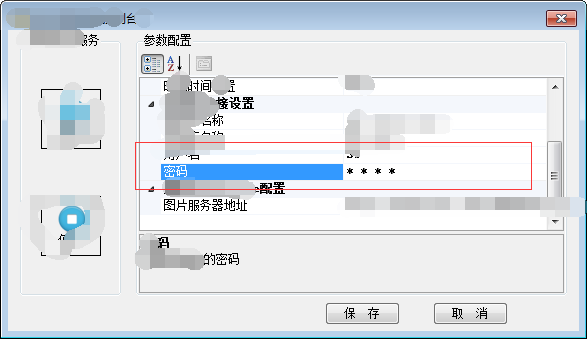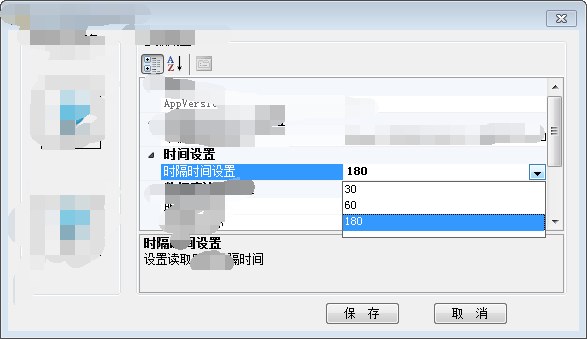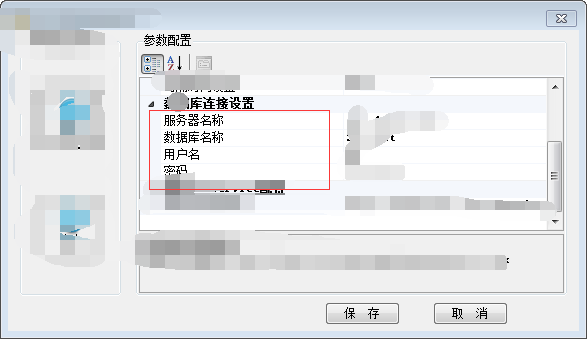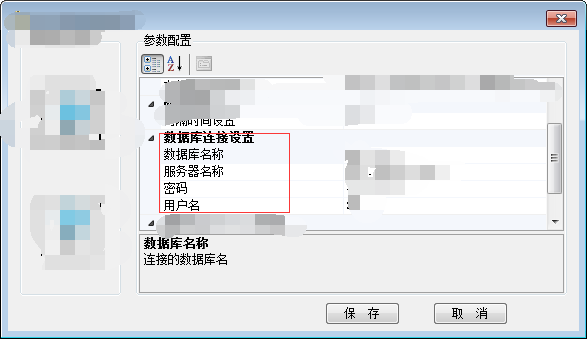C# PropertyGrid控制元件的四個自定義操作
阿新 • • 發佈:2019-02-04
1>PropertyGid 控制元件輸入時顯示隱藏密碼為(*)
單獨寫一個PasswordStringConverter 類;
using System.ComponentModel;
using System.Globalization;
namespace Test
{
public class PasswordStringConverter : StringConverter
{
public override bool CanConvertFrom(ITypeDescriptorContext context, Type sourceType)
{
return 呼叫;
private string _pwd;
[CategoryAttribute("資料庫連線設定"),
DisplayNameAttribute("密碼"),
DescriptionAttribute("連線資料庫的密碼"),
TypeConverter(typeof(PasswordStringConverter)), //關鍵(過載)
]
public string Pwd
{
get { return _pwd; }
set { _pwd = value; }
}效果:
2>PropertyGid 控制元件選擇下拉框值
單獨寫一個SetTimeItem 類; //@! SetTimeItem 隨便建
using System.ComponentModel;
namespace Test
{
public class SetTimeItem : StringConverter
{
public override bool GetStandardValuesSupported(ITypeDescriptorContext context)
{
return true;
}
public override StandardValuesCollection GetStandardValues(ITypeDescriptorContext context)
{
//@! 編輯下拉框中的items
return new StandardValuesCollection(new string[] { "30", "60" ,"180" });
}
//@! true: disable text editting. false: enable text editting;
public override bool GetStandardValuesExclusive(ITypeDescriptorContext context)
{
return true;
}
}
}呼叫;
private string _SetTime;
[DisplayNameAttribute("時隔時間設定"),
CategoryAttribute("時間設定"),
DescriptionAttribute("設定讀取服務時隔時間"),
TypeConverter(typeof(SetTimeItem)),
]
public string SetTime
{
get { return _SetTime; }
set { _SetTime = value; }
}效果;
3>PropertyGid 控制元件排序
(如果不排序,它會自動按照拼音首字母給你排序,排版變得比較醜)
單獨寫一個PropertySorter類;
using System;
using System.Collections;
using System.ComponentModel;
namespace Test
{
public class PropertySorter : ExpandableObjectConverter
{
#region Methods
public override bool GetPropertiesSupported(ITypeDescriptorContext context)
{
return true;
}
public override PropertyDescriptorCollection GetProperties(ITypeDescriptorContext context, object value, Attribute[] attributes)
{
//
// Thise 這個overrid返回屬性的列表
//
PropertyDescriptorCollection pdc = TypeDescriptor.GetProperties(value, attributes);
ArrayList orderedProperties = new ArrayList();
foreach (PropertyDescriptor pd in pdc)
{
Attribute attribute = pd.Attributes[typeof(PropertyOrderAttribute)];
if (attribute != null)
{
//
// 如果找到的屬性,然後建立一個物件持有它
//
PropertyOrderAttribute poa = (PropertyOrderAttribute)attribute;
orderedProperties.Add(new PropertyOrderPair(pd.Name, poa.Order));
}
else
{
//
// 沒有這個屬性就給它一個0
//
orderedProperties.Add(new PropertyOrderPair(pd.Name, 0));
}
}
//
// 執行實際的使用價值PropertyOrderPair類IComparable排序的實現
//
orderedProperties.Sort();
//
// 構建一個字串列表的命令名稱
//
ArrayList propertyNames = new ArrayList();
foreach (PropertyOrderPair pop in orderedProperties)
{
propertyNames.Add(pop.Name);
}
//
// 通過PropertyDescriptorCollection排序的有序列表
//
return pdc.Sort((string[])propertyNames.ToArray(typeof(string)));
}
#endregion
}
#region Helper Class - PropertyOrderAttribute
[AttributeUsage(AttributeTargets.Property)]
public class PropertyOrderAttribute : Attribute
{
//
//簡單屬性允許指定一個屬性的順序
//
private int _order;
public PropertyOrderAttribute(int order)
{
_order = order;
}
public int Order
{
get
{
return _order;
}
}
}
#endregion
#region Helper Class - PropertyOrderPair
public class PropertyOrderPair : IComparable
{
private int _order;
private string _name;
public string Name
{
get
{
return _name;
}
}
public PropertyOrderPair(string name, int order)
{
_order = order;
_name = name;
}
public int CompareTo(object obj)
{
//
// 結對物件通過排序順序的值
// 平等的價值觀得到相同的等級
//
int otherOrder = ((PropertyOrderPair)obj)._order;
if (otherOrder == _order)
{
//
// 如果未指定順序,按名稱排序
//
string otherName = ((PropertyOrderPair)obj)._name;
return string.Compare(_name, otherName);
}
else if (otherOrder > _order)
{
return -1;
}
return 1;
}
}
#endregion
}
//@! 瞎扯淡,我也不沒仔細看程式碼,不過我要的功能達到,可以看看效果圖呼叫;
(在PropertyGrid屬性類裡面新增)
using System.ComponentModel;
using Utility.SW.Common;
using Utility.SW.NRegistry;
namespace Test
{
[TypeConverter(typeof(PropertySorter))] //@! 用來排序
public class TestConfig
{
private string _ip;
private string _database;
private string _uid;
private string _pwd;
#region 資料庫設定
[CategoryAttribute("資料庫連線設定"),
DisplayNameAttribute("伺服器名稱"),
DescriptionAttribute("資料庫伺服器名(IP)"),
PropertyOrderAttribute(1) //@! 序號(排序)
]
public string IP
{
get { return _ip; }
set { _ip = value; }
}
[CategoryAttribute("資料庫連線設定"),
DisplayNameAttribute("資料庫名稱"),
DescriptionAttribute("連線的資料庫名"),
PropertyOrderAttribute(2)
]
public string Database
{
get { return _database; }
set { _database = value; }
}
[CategoryAttribute("資料庫連線設定"),
DisplayNameAttribute("使用者名稱"),
DescriptionAttribute("連線資料庫的使用者名稱"),
PropertyOrderAttribute(3)
]
public string UId
{
get { return _uid; }
set { _uid = value; }
}
[CategoryAttribute("資料庫連線設定"),
DisplayNameAttribute("密碼"),
DescriptionAttribute("連線資料庫的密碼"),
PropertyOrderAttribute(4)
]
public string Pwd
{
get { return _pwd; }
set { _pwd = value; }
}
#endregion
}
}
效果;
不排序的效果是
4>PropertyGrid屬性排序
下面的連線是他們寫的點選直接轉到他這個只是在當前類上面新增
還有種是加(/t)
class Test
{
[Category("Advanced")]
public int Age { get; set; }
//@!
[Category("\tGeneral")] //<--
public string Name { get; set; }
}嘻嘻,這些東西都是網上有的資源,我也是借鑑..寫在一起了,以後就容易可以找到些,




